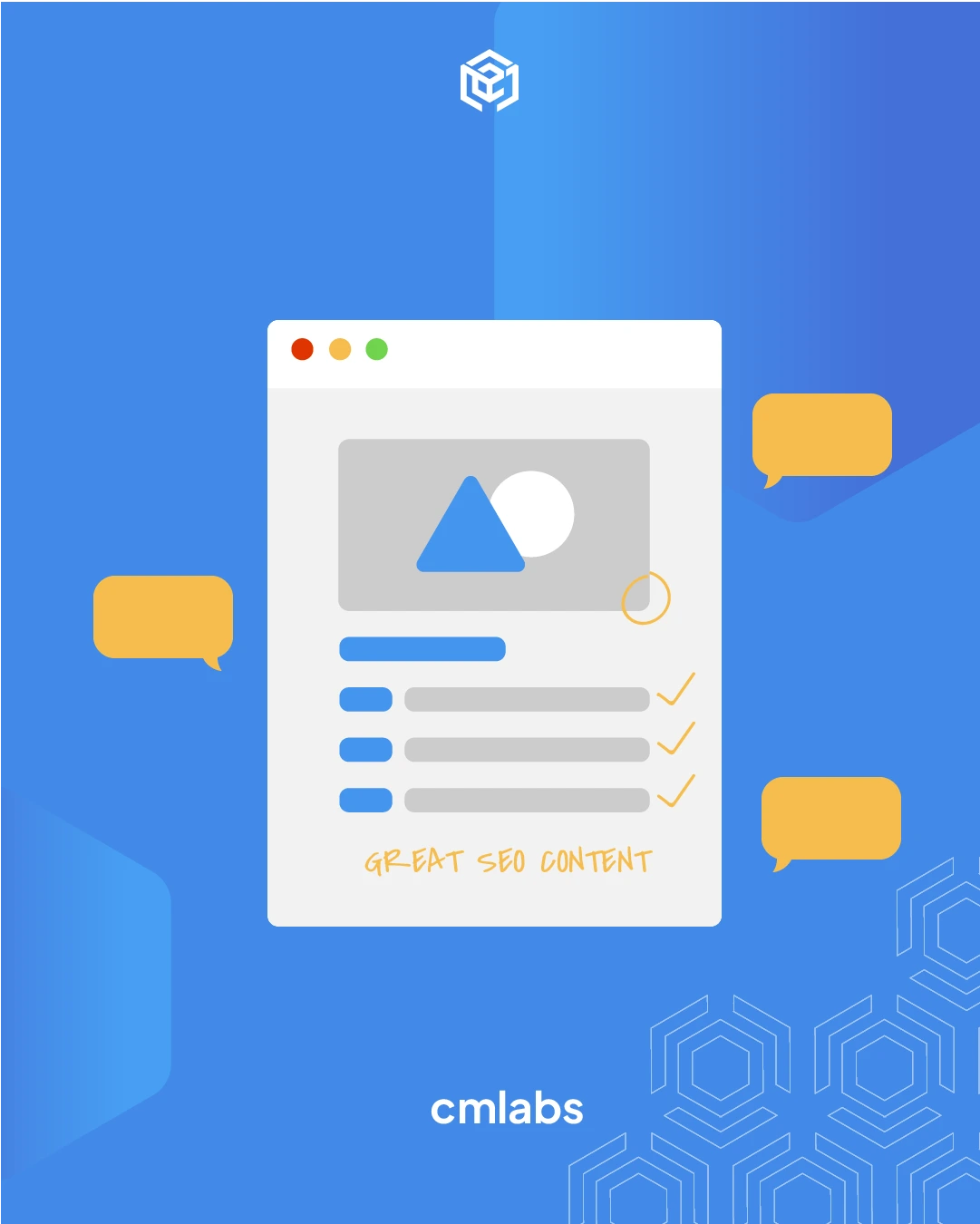We use cookies
This site uses cookies from cmlabs to deliver and enhance the quality of its services and to analyze traffic..
SEO SERVICES
Conduct in-depth technical website audits, strategically develop website projections, and increase your website authority.
ASO SERVICES
Elevate Your App’s Presence with Our Expert ASO Services – Boost Visibility and Drive Downloads!
WRITING SERVICES
We offer a variety of writing services to suit different business necessities. Reach broader audiences or lead specific industries? We've got you covered!
SEOlutions
A unified source of truth!
SEO & Digital Maternity Solution
SEO & Digital Maternity Solution: Leverage Cross-Platform Insights to Elevate Your Strategy with Expert Consultation
SEO & Digital Maternity Solution
Data Solution options:
Starting from Rp200 mio
Reinventing how a company get creative treatments
A new way to get your creative needs done. Agile team, efficient cost, and expedient way in a flexible yet scalable subscription plan!
Creative-as-a-Services
CaaS package options:
Based on Subscription
Pioneer in digital marketing software powerhouse
We’re excited to unveil our new range of Tech Solutions designed to drive your digital success. Whether you’re looking to enhance your website’s performance, streamline your tech stack, or unlock deeper insights from your data, we’ve got you covered.
Starting from Rp250 mio
Our Clients
Research and innovation center for digital transformation
Digital marketing combines technical skills and business knowledge at every stage. For marketing teams, improving budget management efficiency is crucial, as time is an invaluable resource that should be used wisely. At Sequence, we are dedicated to empowering you to optimize efficiency and strategic planning, ultimately enhancing the impact of your digital marketing efforts.
Subscription-based (IDR1,800/keyword)
Our Clients
BeyondSEO
References
SEO Tools for Webmasters
SEO Tools for Writers
SEO Tools
FIND THE SUITABLE PARTNERSHIP FOR YOUR COMPANY
Check out which cmlabs partnership program suits your company
WHITE LABEL SEO
for CorporateYour company is granted exclusive partnership rights to provide SEO services to our important clients, and we will provide a dedicated backend team to support your efforts.
AFFILIATE PROGRAM
for BizdevA new affiliate program is being introduced for skilled marketers and individuals with strong networks, offering commissions of up to 7% for generating profits independently.
DIGITAL AGENCY
for Marketing Partnerscmlabs is an essential partner for digital agencies, providing a unique selling proposition in Search Engine Optimization (SEO).
BACKLINK PARTNERSHIP
for Media / BloggerWe have a vast database of bloggers and media outlets across Indonesia, categorized by region and media type, giving our clients an edge in managing their media and SEO activities.
OFFICIAL TRAINING
We provide ongoing professional development and support to SEO professionals to ensure they are equipped to meet market demands.
JOIN AS CONTRIBUTOR
for Content WriterGreat opportunity for SEO Writers around the world. T&C applied!
ACADEMIC PARTNERSHIP
Through partnerships with universities in Indonesia, cmlabs has helped align academic curricula with industry demands.
Partnership
Sector & Industries
Tell us your SEO needs, our marketing team will help you find the best solution
As an alternative, you can schedule a conference call with our team
Schedule a Meeting?Contact
Survey
We use cookies
This site uses cookies from cmlabs to deliver and enhance the quality of its services and to analyze traffic..
Last updated: Jun 20, 2024

Backlog is a term that refers to a list of tasks that need to be completed or addressed by a team or individual.
This term is often used in the product development process, whether it be software by DevOps engineers, general business products, or even in large-scale project management.
It is a list of tasks in product management organized based on priority levels or scales to ensure that the completion process runs more effectively.
It also helps facilitate team collaboration and ensures that the most crucial work is prioritized and given more attention.
In the product development process, the prioritized task list is commonly referred to as the product backlog.
Product backlog is an effective technique for breaking down tasks based on a priority scale.
In general, this technique involves categorizing tasks into different classes and specific time periods to create a more structured working process. Several factors serve as the basis for determining these priorities, such as:
After you understand “what is backlog”, you might be as well curious about why this priority list is crucial for design and product development teams.
In general, this list of tasks will continue to evolve and encompasses all aspects of product development.
Its existence is crucial because only through the backlog can the efficiency of time and workflow in product development run smoothly and minimize obstacles.
It serves as a container to hold various inputs related to product development and management, discussing features or quality improvements for a product.
With this list, all these ideas and suggestions can be documented along with many other priorities.
When the time comes for evaluation, the product owner (the person responsible for the project) can conduct discussions to determine whether the suggestions recorded within the platform are worth implementing or not.
It's worth noting that the log also includes types such as bug fixes, the addition of new features, and infrastructure updates.
Therefore, it not only serves as a guide to ensure tasks run efficiently but also as a solid management foundation to improve quality and responsiveness to market needs. Some objectives of it include:
In general, there are three types of backlog categorized based on the type of tasks. Here's a more detailed explanation.
This is a vital part of software development that ensures the sustainability and robustness of the system.
Its main focus is on building, maintaining, and improving the system's architecture. Therefore, task explanations in this kind are generally brief, concise, and clear to provide concrete guidance to the development team.
Example: "Upgrade cmlabs tools to the latest version."
Unlike the previous type, the functional type generally provides detailed explanations about a requirement in the development process.
This kind of list is done through user stories to visualize how the system will be used. Therefore, its explanations use three main components:
Example: "As a user, I use the Title & Meta Checker Tool by cmlabs, so that metadata visualization can be navigated accurately."
It is a list of tasks that arises as a consequence of work quality beyond expectations. This phenomenon usually occurs after the product has been launched, making the technical debt backlog always a top priority to address.
Technical debt orders are generally conveyed succinctly and clearly and include information about the necessary fixes.
Example: "An error occurs when trying to repeat the checking process sequentially."
Product backlog is a crucial part that plays a role beyond just being a task list. Hence, there are some fundamental characteristics that need to be considered to ensure the effectiveness and smoothness of the development process. Below are some of the characteristics of a well-built backlog examples:
If you intend to maximize online business marketing strategies, you need to ensure that the development process for the website or web app runs smoothly first.
As for that, integrative and continuous collaboration among team members is required. Here is a more complete guide to how to create it optimally.
The process can be started with a crucial step: determining Product Goals. The Product Owner plays a crucial role in this step since data related to business needs or product goals must be thoroughly understood first.
To identify business needs to be met or problems to be addressed, you can analyze:
The next step is to determine PBI. In this process, you need to consider several main components of PBI, such as:
The next step is to set the priority sequence. This is a critical step to ensure the team can focus on work.
To determine the priority scale, you can observe Business Value Analysis. This means PBIs are ranked from the highest to the lowest value.
After PBIs have prioritization and weight estimates, the next step is to determine sprint velocity, which is the amount of work that can be completed in one sprint.
WDYT, you like my article?
Couldn't find result for "Mulki" try to search with different keyword
Suggestion:
Tell us your SEO needs, our marketing team will help you find the best solution
As an alternative, you can schedule a conference call with our team
Schedule a Meeting?



cmlabs Jakarta Jl. Pluit Kencana Raya No.63, Pluit, Penjaringan, Jakarta Utara, DKI Jakarta, 14450, Indonesia
(+62) 21-666-04470These strategic alliances allow us to offer our clients a wider range of SEO innovative solutions and exceptional service.

Psst! Hey there, SEO Stats and Tools SEO company! If you've ever planned of conquering the Vietnam market, you've come to the right place!